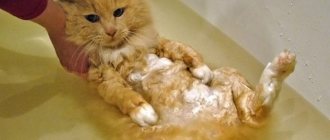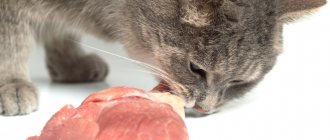Neutered cat
There is a misconception that a cat cannot be sterilized before the first birth. There is no need to wait until the pet lambs, especially if the owners do not plan to have kittens in the future. If a cat does produce offspring, the question often arises about its sterilization, in particular, how much time should pass so that the operation does not harm the animal?
In the article, we discussed when a cat can be sterilized after giving birth, how long it should take, and whether surgery is possible during lactation. You will also learn when the procedure is contraindicated and recommendations.
Indications for sterilization
If the owner does not plan to periodically receive offspring from his cat, then veterinarians recommend sterilization. The procedure will not only keep the house calm, but will also protect your mustachioed pet from many diseases. In this case, it is important to take into account the age characteristics and health status of the pet, choose the right method of intervention, and know the nuances of care after the operation.
There are both pros and cons to neutering cats, as outlined in the table below.
To be or not to be?
pros
- You don't have to get rid of kittens.
- The animal's behavior will not cause any inconvenience.
- Timely sterilization helps to increase the life expectancy of your pet.
- It is possible to prevent the development of many diseases of the cat’s reproductive system associated with estrus without mating, childbirth and hormonal changes.
- The risk that your pet will get lost or become infected with an infectious disease in case of escape is reduced to a minimum.
Minuses
- Surgery under anesthesia is stressful for the animal’s body.
- The likelihood of complications developing in the postoperative period.
- The risk of developing obesity, diabetes and other diseases associated with changes in hormonal levels.
- Recovery takes a long time (about two weeks) and requires constant wearing of special devices.
- If the owner “changes his mind”, it will be impossible to restore the ability to give birth to kittens.
In addition to the fact that sterilization of a cat is carried out due to the desire of the owner, the operation can have a therapeutic purpose and be planned or emergency.
Among the indications:
- neoplasms in the reproductive organs;
- inflammatory processes;
- changes in the mammary glands caused by hormones;
- poorly performed earlier sterilization;
- prevention of various diseases (tumors, cysts, purulent processes, and so on).
For some medical indications, the uterus and appendages are removed immediately after childbirth.
These include:
- atonic bleeding;
- placental defects;
- uterine rupture;
- pathologies of the uterus and ovaries (tumors, endometriosis) detected during pregnancy.
These indications can only be determined by a veterinarian. After such manipulations, your pet requires special care with a long recovery period.
Sterilization - a solution or a necessity?
Is it possible for a neutered cat to become pregnant?
Cat after sterilization
For various reasons, some owners insist on incomplete sterilization of their cat. This is where the danger of an unplanned cat pregnancy lies.
An absolute guarantee that a cat will not give birth to more kittens is provided only by complete removal of the uterus along with the ovaries .
Repeated sterilization of a cat during pregnancy
Partial preservation of the reproductive organs - if at the same time the cat also has the opportunity to contact with relatives - always leaves, although minimal, the risk of offspring .
Tubal occlusion
Tubal occlusion especially often fails : the catgut with which the fallopian tubes were tied very quickly dissolves, and their patency is restored in a short time. Adhesive processes in cats are very rare; by nature, these animals, as already mentioned, are extremely fertile.
Sterilization operation
It is also common to encounter unscrupulous visiting veterinarians with fake diplomas who, after charging a tidy sum for sterilization and making a small suture on the tailed patient’s stomach for visibility, do not perform the operation as such.
Castration
It is the surgical removal of reproductive organs: the ovaries and uterus in a cat, or the testicles in a cat. The operation is performed under general anesthesia. There are several methods of castration.
Most often, females have all their reproductive organs removed: the ovaries, uterus and fallopian tubes. But in some cases (young cats) the uterus is left.
Castration of a female is an abdominal operation, a fairly serious surgical intervention. Therefore, it makes sense to spend money on endoscopic (laparoscopic) castration .
This is the most modern and least traumatic method. The instruments are inserted through two (sometimes three) small incisions on the abdomen, which greatly reduces the risk of infection in the abdominal cavity, facilitates and shortens the postoperative period. The incisions are so small that stitches are not required - they are sealed with medical glue.
Castration is a surgical procedure
Cat sterilization and religion
Sterilization of cats from the point of view of Christianity: In Christianity there is no direct prohibition on sterilization/castration of animals. Each priest has his own opinion on this issue. Some consider sterilization a sin, because... man should not interfere in divine affairs, and God did not create animals for our pleasure. Others believe that castration is not murder, and that if we can kill animals for meat, and also use them for our own needs (for example, plowing with horses and oxen, transporting goods, etc.), then castrate even more so. After all, man is created in the image and likeness of the Lord, which means his needs are paramount. At the same time, castration should not lead to the death of the cat or serious injury, and should also be painless.
Sterilization of a cat in Islam: There is no direct prohibition on castration of animals either in the Koran or hadith. The Prophet Mohammed treated animals very carefully, but there is evidence that he repeatedly sacrificed castrated animals, which means he did not consider them sick or defective. Of the four Sunni madhhabs, the Hanafis do not see anything wrong in the castration of all animals, the Malikis speak only about the castration of beef cattle and also do not condemn it, and the Shafi'ites and Hanabalites condemn the castration of all animals with the exception of beef cattle. Shiites do not object to the castration of domestic animals. Modern Muslim jurists believe that if castration occurs under anesthesia and does not lead to death or injury, then there is no sin in it; because an abundance of cats can harm people, as can sexual activity in animals.
Neutering a cat in Judaism: The Torah strictly prohibits castrating any animal, even by a non-Jew. However, it is also impossible to give an animal drugs that impair its sexual function. At the same time, Jews are allowed to use animals for their needs, for example, you can pluck a feather from a live goose if there is no other feather.
Sterilization of a cat in Buddhism: Buddhists are prohibited from causing suffering to animals, and generally interfering with their “natural” life. For a Buddhist, sterilizing a cat is only possible if it saves the animal’s life (for example, in case of uterine cancer). In fact, a Buddhist should not have a pet at all, because... it limits his freedom and causes him suffering.
In general, the following should be noted:
1) All world religions preach humane and caring attitude towards animals, and prohibit the abuse of them for your own pleasure
2) In all world religions it is forbidden to kill helpless creatures that do not cause harm and are not capable of causing it (drowning kittens, throwing them out into the street, taking them away from their mother before they get stronger (3 months))
3) All world religions condemn the deliberate infliction of suffering on an animal, therefore, feeding a cat with hormonal pills that cause serious complications is a sin, as is not giving him the opportunity to fulfill his mating needs in the proper amount (every heat cycle)
4) All religious prohibitions on castration are associated with two aspects: you cannot interfere with the nature of animals and you cannot hurt them. However, in the time of the Prophets, there were no “pets” as such, and there were no problems with stray cats. In addition, there was no anesthesia that would allow castration to be performed painlessly, and there were no experienced veterinarians who could castrate an animal without causing death or injury.
5) All religions (except Buddhism) recognize that animals were created for humans, and not humans for animals; accordingly, if an uncastrated animal causes significant harm to people, and its castration will be useful to both humans and animals, castration will not be a sin. And cats mark, yell and behave aggressively, which causes trouble for both their owners and those around them; at the same time, as already written above, castration brings obvious benefits to cats.
Thus, a believer has three paths:
1) do not have cats as pets;
2) do not castrate the animal, mate it with healthy and vaccinated partners every time it wants, raise ALL kittens up to 3 months and give it only to trusted, good hands;
3) castrate an animal in violation of the letter or spirit of religious laws.
It is worth noting that religious laws are constantly and regularly violated, often with the approval of the clergy, since sin is used for good. For example, it is permissible to violate the commandment “thou shalt not kill” when it comes to protecting one’s family or homeland, although murder remains a sin for which one should sincerely repent.
Chemical sterilization of cats
Unlike cats, of all types of non-surgical sterilization, only medical (temporary) sterilization is possible for cats. Since the cat's genitals are located in the abdominal cavity in close proximity to other vital organs, radiation sterilization of a cat seems too difficult, although not absolutely impossible. However, in Russia, even experiments in this area were not carried out.
Medical sterilization of cats using the drug "Superlorin" is also not recommended, because Most likely, for females it is irreversible and can lead to various complications. Other hormonal drugs used in veterinary medicine are also unsafe, but have been better studied.
The best remedy for regulating estrus in cats and used for hormonal imbalances and nymphomania in breeding cats is “Covinan”. It is injected ONLY during the period of sexual rest and, as a rule, according to the following scheme: the second injection 3 months after the first, the third - 4 months after the second, the fourth and subsequent ones - 5 months after the previous one. In this way, sexual peace is achieved.
Another hormonal contraceptive, Depo-Provera, is also injected during periods when there is no estrus according to the scheme: the second injection three months after the first, the third and subsequent ones six months after the previous one. This drug is not veterinary, but “human”, and for this reason it is much more dangerous than “Covinan”. However, it is very popular due to its relative cheapness.
Not long ago, a new drug “Perlutex” appeared on the market for long-term delay of estrus in cats. The drug is given during the period of sexual rest, 1 tablet per week, 1 course should not exceed more than 5 months. The drug is contraindicated in animals during lactation, with diseases of the genital tract, liver, pancreas and diabetes. It is believed that Perlutex is the most gentle hormonal drug, but there is little experience with its use. There are also cases where cats went into estrus while taking this drug.
Medical sterilization of a cat is a temporary measure intended for breeding animals suffering from debilitating estrus, as well as for cats for which surgical intervention is contraindicated. Long-term use of hormonal drugs to regulate a cat's sexual behavior almost always leads to pyometra and the development of cancerous tumors.
Spaying or neutering a cat
It is believed that the operation to stop the sexual function of a cat is called sterilization, and a similar operation for cats is called castration, but in fact, this is incorrect. From a medical point of view, neutering a cat involves ligating the fallopian tubes (tubes connecting the ovaries to the uterus). With such an operation, the cat cannot become pregnant, but continues to show all signs of sexual heat and mate with cats. Moreover, over time, the pipes can resume their operation. Castration involves the removal of either the ovaries and uterus (ovariohysterectomy) or only the ovaries (oophorectomy). So, in fact, this article is about castration of cats, but we call it as people are accustomed to. Moreover, in fact, modern veterinarians do not ligate cats’ tubes.
Sterilization
It is also performed under general anesthesia, but all organs remain in their places. A surgeon ligates a cat's fallopian tubes.
What does such an operation give? Only inability to fertilize . All the rest:
- the production of sex hormones, sexual desire and all sorts of “disgrace” that accompany it, as well as urine markings, are not going away. And this operation is also much more complicated.
is ABSOLUTELY pointless for both the animal and its owner .
The cat still suffers from the inability to satisfy its natural needs, the owners stubbornly cover up the marks and patiently listen to the calling howl.
You can sterilize a cat, either a cat that has given birth or a cat that has not given birth.
Is it possible to sterilize a cat that has given birth?
Owners often wonder: when is it possible to sterilize a cat after giving birth? It is best to sterilize a cat not after giving birth, but immediately before the first heat, i.e. about a year. However, it is possible to sterilize a cat after the first birth, for the indications listed above or if there is no need for mating.
The time of the operation depends on the feeding of the kittens: 2-4 weeks need to be waited for a non-breastfeeding cat and 2-3 months for a nursing mother cat. The minimum period between births for non-lactating cats is 3 months, for nursing cats it is about 4-5, so the optimal time for sterilization after the birth of kittens is 2 months.
It is impossible to carry out the intervention immediately after lambing, since the uterus has not yet acquired its previous appearance and hormonal disorders have not recovered. During pregnancy, the uterus changed its shape, size and grew thicker with blood vessels, so any surgical manipulations in the postpartum period can stimulate heavy bleeding. In addition, it loses its elasticity, making it difficult for the surgeon to apply a ligature, which also stimulates hemorrhage.
The optimal time for sterilization after childbirth is 2 months
It is not advisable to sterilize during postpartum heat. The operation itself does not threaten the animal, but the stitches heal much more difficult. Also, you should not allow your pet to come into contact with an uncastrated cat at this time, which is even more harmful than sterilization itself. Hasty haste in this matter is a great risk to the life of the pet.
What to do if your cat is pregnant? Is it humane to sterilize?
The owners are confident that they will easily accommodate all the kittens. This often happens: babies are looking for a new home, but few people follow their future fate. Unfortunately, often kittens do not end up in the most reliable hands, even if at first it seemed that their dream owner had been found. And even more often, people are not ready to deal with the offspring of their favorite and rush to get rid of the extra tail, give it to the first person they meet, or simply throw the poor thing out the door.
The truth is that the number of cats is already so high that not everyone who needs a home and shelter will be able to find it. Read more about this here: How to prevent new kittens from appearing in your yard.
Are you ready to take on such responsibility? Most likely no.
Therefore, we want to emphasize the official position of the “Kotoshef” project: in the current situation with the number of homeless animals, it is impossible to allow a cat to become pregnant.
But is it necessary to sterilize an already pregnant cat?
This is a very difficult question and there is no clear answer to it and never will be. In addition, all situations and strengths of a volunteer are individual and each Kotochef will have to decide this on his own, honestly weighing all the pros and cons with himself, from the point of view of:
- Preserving the health and life of the cat, first and foremost
- Risk assessments during and after sterilization or childbirth
- Assessing your capabilities - physical, moral, financial, time
- Problems with the number of stray animals
This must be a balanced decision from all sides. It is very important that you should not be pressured by other people’s opinions! Sterilizing a pregnant cat is a very serious step, just like giving birth, and therefore requires a very responsible approach.
Many veterinarians and animal protection organizations rather agree that this should be done, but taking into account the following factors:
- gestational age
- cat's health status
- blood parameters (UAC and HD)
- test results for dangerous viral diseases
- condition of organs and fetuses according to ultrasound
- cat age
What are the health risks of a cat being spayed during pregnancy?
This operation is called “extription of the gravid uterus” and is more dangerous than regular planned sterilization. It is impossible to call this operation harmless and simple.
The uterus with the fetuses is abundantly filled with blood - it contains a large volume of blood of the total amount of blood in the body. In addition, the cat's uterus is very long and its tissues are densely penetrated by a network of blood vessels.
The two most dangerous risks when spaying a pregnant cat, which can lead to death:
1) Loss of a large volume of blood due to removal of a full uterus
2) The risk of severe bleeding due to the abundance of blood vessels in the uterus
Carrying out such an operation in a small clinic, without donor blood, without the possibility of intubation and oxygen inhalation, can be life-threatening for the cat. Especially if the cat has anemia according to blood indicators - a decrease in hemoglobin, hematocrit, albumin, blood glucose, etc. Therefore, the anesthesiologist, and not just the surgeon, should also assess the cat’s condition.
As the gestational age increases, the risk to the health and even the life of the cat increases. On average, a cat's pregnancy lasts only 60-65 days. Therefore, it is important not to delay, but to carry out sterilization at the earliest stages of pregnancy - in the first half of pregnancy. Starting from the 6th week of pregnancy, the risks of surgery increase many times over, since in the last 2 weeks before birth the most active growth of the fetus and its full development occurs.
With an abrupt termination of pregnancy, there is a strong hormonal jump (progesterone drops sharply and prolactin jumps), so consequences in the form of lactostasis and mastitis are common. Infectious complications (septic peritonitis), a longer period of recovery and healing due to the large size of the suture also occur.
What are the health risks for a cat during birth?
Pregnancy and childbirth are a natural physiological process. But it also has its own difficulties and characteristics. They do not add health, especially to exhausted, sick and very young (6-7 months) or, conversely, elderly street cats.
About 15-20% of births in cats are complicated by dystocia - this is a weakness of labor when the cat cannot give birth on its own. The reasons may be different: a cat gives birth to one kitten, gets tired and cannot give birth to others; the kitten is lying in the wrong position or the fetus is too large; due to the anatomical features of the birth canal. Therefore, childbirth may require the participation of a doctor, either medically (stimulant drugs) or surgically (caesarean section). If the cat is severely emaciated, she may be even more weakened by the time of cesarean section.
It is important, before making a decision to give birth to a cat, to take into account the factors described above in order to exclude serious pathologies of the cat's health. Assess her tests for the level of general exhaustion, the absence of tumors and other organ problems, the size, condition and anomalies of fetal development, severe infectious diseases (VLK, FIV, panleukopenia), dangerous for the cat and her offspring. Is it worth subjecting a severely malnourished cat to such stress? But if the process has already begun, then all that remains is to accept it.
If the cat is healthy and you decide to give birth, keep in mind that during pregnancy, especially in outdoor cats, there is a deficiency of calcium and folic acid. Therefore, you must provide your cat with adequate care, increased nutrition and, most likely, vitamin supplements, and also be prepared for emergency veterinary care during childbirth, as it occurs unexpectedly. A heavily pregnant cat should not be left unattended. Discuss these points and prices for veterinary services in advance with a veterinary reproductive specialist.
The ethical side of the issue.
It’s no less difficult when you make a decision about someone else’s life. Therefore, it is necessary to be guided here not only by pity, but also by common sense, first taking into account the physiological risks and state of health of the cat. Assess whether you are ready to care for your cat's offspring for several months. If you already have a lot of animals, won't this be an overwhelming burden for you? It is not so easy for newborn kittens to find a safe home. The choice of a clinic and surgeon must be approached equally responsibly. If the clinic does not provide anything for resuscitation of the animal, there is no donor blood in case of emergency bleeding, then the consequences can be fatal. If you are ready to bear responsibility for the fate of kittens, you should not be pressured by someone’s opinion or censure from others.
How do kittens feel?
Unfortunately, this is unknown. If the doctor knows how to perform this operation correctly and strives to make it as painless as possible, then the kittens will fall asleep along with the mother cat, but the kittens will not wake up. If the doctor is inexperienced or finds it difficult to answer the question: “What actions will follow if the kittens do not fall asleep in the womb?” (which, alas, happens), then, unfortunately, for kittens this will be a painful death.
Therefore, before sterilizing a pregnant cat in the later stages, you also need to check with the doctor whether he injects additional anesthesia into the uterine artery in case the kittens do not fall asleep. In some cases, very late in pregnancy, kittens have to be euthanized individually.
No matter how bitter it may be, you take this responsibility upon yourself, so you must know the truth and have an idea of the complexity of each process, and not believe that it is all simple and easy.
What is the opinion of the church?
Here is what Archpriest Peter Dynnikov, rector of the Church of the Prophet Elijah the Prophet, answers: “We sterilize adult animals that have already given birth and do not sterilize animals that come to us pregnant. They live in special conditions, give birth and after some time we sterilize them. Sterilization of homeless animals is a vital necessity.”
Is sterilization expensive?
Depending on the city and clinic, sterilizing a cat costs an average of 1,500 to 5,000 rubles. It’s the same as one visit to the dentist with a regular filling. There are people who firmly believe that sterilization is beyond their means. However, at the same time, they forget to calculate how much it can cost to maintain 5-6 kittens for at least 2 months, and how much effort and time it will take to find the kids a safe home. And if you also remember that a cat can give birth 3-4 times a year and/or develop a serious illness or not give birth at all, then the conclusion becomes obvious: sterilization is truly beneficial.
Read more about this in the article: Truth and myths about sterilization.
The cat gave birth to kittens, what to do with them now?
Congratulations on the addition of these pink heels and noses - always beautiful!
of these pink heels and noses - always beautiful!
Study materials on caring for kittens.
If you don’t plan to keep the entire furry company for yourself, then start looking for a new home for the kids. Take this seriously, because you have already taken responsibility for the kittens. Be careful in your search for future owners: evaluate their intentions and readiness for the appearance of a pet in the house. Don’t be lazy and take an unobtrusive interest in the life of the kittens in their new home.
Remember that kittens should absolutely not be given to bird markets or to grandmothers with a box full of cats at the metro station, as this reduces the baby’s chance of a happy life to zero. Also, under no circumstances should you give kittens to people who have not asked you for it. Living beings are not toys!
You can read more about selecting hosts in our articles:
How to find new owners?
How to choose a good owner?
Information resources on which advertisements can be posted and rules for posting Facebook, Vkontakte, Odnoklassniki
Sterilization during lactation
So, how long after giving birth can a cat be sterilized? Nursing mothers should hesitate with sterilization, because after the intervention, lactogenesis will stop and milk will not be produced. After the operation, the milk will last for no more than 5 days. The owners will have to buy special food and spend time feeding the kittens, something that their mother could do much easier and better. In addition, anesthetic drugs pass through the milk to the kitten, and in cases of severe overdose, they become drowsy, refuse to eat, and may even die.
If for some reason the cat does not feed her children, the operation still needs to be delayed. The risks of losing a cat are very high, because during lactation the mammary glands can be injured when feeding kittens, which in the future will cause infection of the sutures after sterilization.
It is not advisable to operate on a nursing cat.
The chance of getting pregnant while nursing kittens is very low, so it is best to wait until the cat has recovered from giving birth.
How long should it take before sterilization after childbirth?
The time of the operation depends on the feeding of the kittens: 2-4 weeks need to be waited for a non-breastfeeding cat and 2-3 months for a nursing mother cat.
Is it possible to sterilize a cat immediately after giving birth? You cannot subject your pet to surgery immediately after the birth of kittens, because the uterus has not yet reached normal size and hormonal levels have not been restored. During pregnancy, the uterus changes its shape and size and grows thick blood vessels, so any operation immediately after the birth of kittens can provoke severe bleeding. In addition, the uterus becomes less elastic, and it is more difficult for the doctor to apply a ligature. It can also cause bleeding.
Before giving birth, the animal's hormonal levels change to ensure regular contractions. When kittens are born, the cat’s body begins to rebuild and lactogenesis begins. If the doctor immediately removes the ovaries, which are the main endocrine glands, then the animal receives severe stress as a result of a lack or excess amount of sex hormones. This negatively affects the health of the pet. In addition, lactation stops, and the kittens will have nothing to eat.
The best age for sterilization is 7-8 months
Cat age and sterilization
When asked when it is better to sterilize a cat, veterinary experts answer: it would be good to do it at 7-8 months. It is believed that it is during this period of animal development that all organ systems are fully formed, the cat is ready to conceive, but there has not yet been pregnancy.
Puberty of a pet can occur earlier or later than the specified period. To determine the optimal interval, you will need to periodically show her to the veterinarian and do examinations. Performing surgery on an adult cat or a very young one is fraught with serious complications and health problems in the future. Early surgery may cause developmental delays in the animal.
At what age are cats spayed?
The ideal age for sterilization in cats is a relative concept. The operation can be performed at almost any age; from 6 months to 10 years it is tolerated quite easily. Older individuals may have contraindications or complications. Today, many veterinarians recommend carrying out the procedure up to a year or after the first heat. At a young age, the animal tolerates all manipulations easily and quickly adapts to the new state. He has not yet formed stable habits, which can be stronger than hormones. For example, an adult that is accustomed to marking its territory will likely continue to do so after spaying or neutering. Therefore, it is wise to act on warning and form the pet’s character and habits from a young age. It is believed that by 8 months a cat reaches sexual maturity and can bear and bear offspring up to 4 times a year. But, firstly, this is individual, for some individuals this moment comes earlier, for others later, and secondly, there are breeds in which the offspring grow for a long time and mature only by one and a half to two years. It is too early to sterilize such cats at 8 months, and it is better to select the timing of the operation together with a veterinarian. In general, the bulk of procedures occur between the ages of one and three years.
When not to sterilize
In some cases, sterilization is contraindicated.
Causes:
- Allergy to certain medications.
- The disease and the period immediately after it.
- Recent injury.
- Individual intolerance to anesthesia.
In any case, the cat must first be examined by an experienced veterinarian and give an opinion. Additional examination may be required to identify other contraindications.
Castration is not recommended after 10 years of age, since the risk of postoperative complications is very high. The same applies if the cat is too young; surgery can slow down the development of the animal.
Emergency cases
There are situations when an animal has to be operated on during pregnancy. This problem doesn't happen often.
Indications for sterilization when bearing offspring are:
- serious pathologies requiring immediate surgical intervention;
- high probability of death of the animal during childbirth;
- offspring unwanted by the owner;
- injuries and infectious diseases in a cat, due to which cubs may be born with defects.
Sometimes cats may need emergency sterilization
Serious and life-threatening pathologies that require surgical intervention even during pregnancy and in the first days after childbirth are:
- pyometra – inflammation of the uterus, accompanied by the accumulation of large amounts of pus;
- hematometra - accumulation of blood in the uterine cavity;
- hydrometer - filling the uterine cavity with liquid;
- endometritis – inflammation of the uterine mucosa.
There is no other treatment other than sterilization for the above diseases.
Preparing for surgery
- Choosing a clinic. A few weeks before the proposed procedure, you need to start looking for a good and reputable veterinarian. You need to understand that highly qualified and experienced specialists do not provide services cheaply.
- Diet. Both before the operation and during rehabilitation, the pet should follow a diet. If the cat eats natural food, then the diet should be based on boiled beef and poultry. If the animal is accustomed to dry food, then you need to buy premium food.
- Medical supplies. It is necessary to purchase a collar that will prevent the animal from licking and biting the operated area. You should also ask your veterinarian what medications to buy for treating postoperative sutures. Treatment is carried out within 10 days after the procedure. To prevent the cat from tearing the seams with its claws, many owners purchase a belly bandage.
- A place for rehabilitation. The recovery from anesthesia is individual for each animal: some cats regain consciousness a couple of hours after the operation, while others remain lethargic and drowsy all day. For comfortable rehabilitation, a cat needs to build a soft bed and place it in a quiet and shaded place. During the recovery period, the cat should not be pulled or shouted at.
- Painkillers. The animal will experience pain in the abdomen for several days. Therefore, it is impossible to do without anesthetics. Among human medicines, Papaverine, No-shpa, and Ketonal are suitable for animals. The dosage and therapeutic course are prescribed by the veterinarian. It is forbidden to choose painkillers for your pet at your own discretion, since many human medications are dangerous for cats.
Preparing a cat for sterilization
How to prepare a cat for sterilization
Sterilizing a cat requires preliminary preparation. Except for clinical cases, the animal must be absolutely healthy. This is especially true for vaccinations and antiparasitic treatment.
Vaccination must be carried out at least a month before surgery. It significantly reduces the risk of developing infectious complications in the postoperative period, when the pet’s immune system is weakened. In the absence of vaccinations, before the intervention, the cat is given a serum injection, which ensures stable functioning of the immune system over the next 14 days. Anthelmintic measures are carried out at least 10 days before sterilization.
Preparatory measures also include:
- laboratory tests of urine and blood;
- ultrasound examination of the reproductive organs;
- cardiogram.
At the discretion of the doctor, X-rays, respiratory examinations, and others are additionally prescribed.
Important: immediately before surgery, the animal must be limited in food (8-12 hours before) and water (3 hours before).
You should take care in advance about the carrier in which the cat will be transported from the clinic to home. Additionally, you will need an absorbent diaper in case of involuntary outflow of urine, as well as a sheet or blanket to prevent hypothermia.
Examination of a cat before sterilization
Possible postoperative complications
Complications can be expressed in the form of lethargy and drowsiness, enlarged mammary glands, hernia, lack of appetite, abnormal bowel movements, changes in body temperature, the appearance of a rash, bleeding of the suture, heavy breathing, accompanied by wheezing, pallor or redness of the mucous membrane. Typically, all these symptoms go away on their own within a day or two.
Owners need to take into account that sterilization can lead to complications associated with the mental and physical condition of the animal. Many cats show aggression after surgery and become prone to obesity. Some pets experience problems with the digestive tract; food is poorly digested and leaves the intestines almost undigested.
There are problems with the urinary organs, urinary incontinence is noted, and visiting the litter box is accompanied by pain.
After the operation, a bandage is put on to prevent the cat from licking the stitch.
Veterinarian recommendations
Below are some recommendations based on the most frequently asked questions about this surgery.
- Before performing surgery, the age of the cat must be taken into account. Intervention performed too early or late entails many complications.
- Nursing cat mothers need to delay sterilization until the end of the lactation period. The body will fully recover in at least 2 weeks after the kittens are taken from their mother.
- If the cat does not feed the offspring, the operation cannot be performed earlier than a month after birth.
- A cat needs to give birth at least once before being spayed - a common misconception. This in no way affects the health of the pet or the operation. If you do not need kittens in the future, you need to sterilize at the earliest possible date.
- Before 4 weeks of pregnancy, it is quite possible to carry out sterilization, if necessary.
- Get tested and get the necessary vaccinations, they will help protect your pet from infection.
Cat sterilization surgery
Before surgery, cats should not be fed for 12 hours, this will make it easier for them to tolerate anesthesia. If a cat is suspected of having a serious helminthic infestation, it must be dewormed before sterilization. For older cats, it is also recommended to have a complete blood count, ECG and general x-ray. An ECG is also mandatory for representatives of breeds predisposed to hypertrophied cardiomyopathy.
During sterilization, cats have either only the ovaries (if the cat has not given birth) or both the ovaries and the uterus (if the cat has given birth) through an incision in the side wall of the abdomen. If your cat has already been in heat, then the uterus should also be cut out, otherwise signs of heat may recur.
The operation is performed under general anesthesia, after which stitches are applied (they will either need to be removed after a certain time, or asked to be sewn up with absorbable threads). The seams are covered with a special blanket to prevent the cat from licking them.
The rehabilitation period after sterilization usually lasts 7-10 days.











